SKODA ROOMSTER 2006 1.G Owner's Manual
Manufacturer: SKODA, Model Year: 2006, Model line: ROOMSTER, Model: SKODA ROOMSTER 2006 1.GPages: 274, PDF Size: 48.64 MB
Page 151 of 274
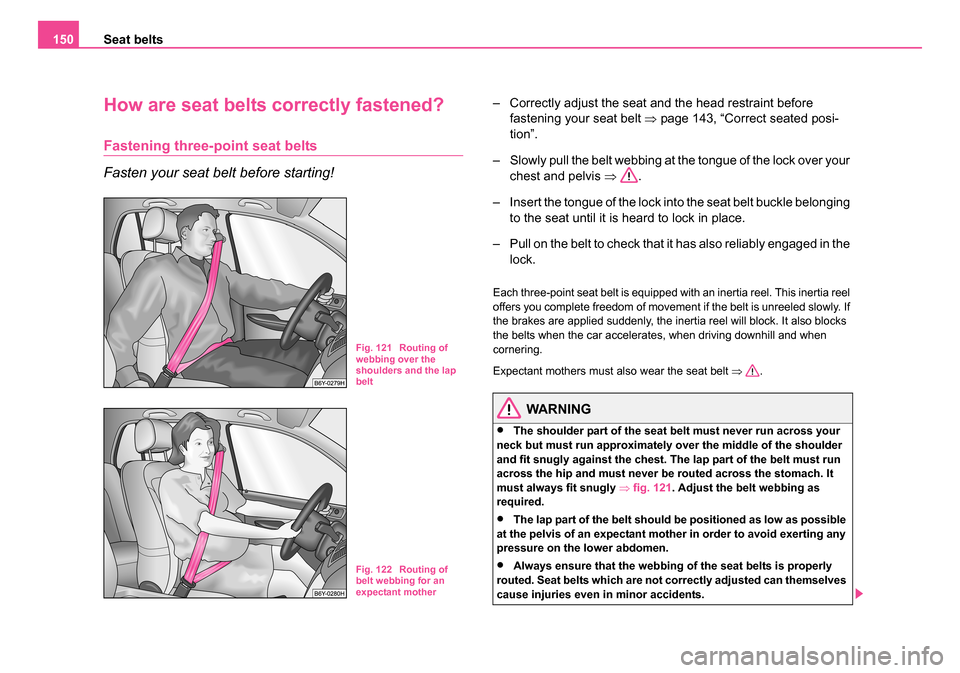
Seat belts
150
How are seat belts correctly fastened?
Fastening three-point seat belts
Fasten your seat belt before starting!
– Correctly adjust the seat and the head restraint before
fastening your seat belt ⇒page 143, “Correct seated posi-
tion”.
– Slowly pull the belt webbing at the tongue of the lock over your chest and pelvis ⇒.
– Insert the tongue of the lock into the seat belt buckle belonging to the seat until it is heard to lock in place.
– Pull on the belt to check that it has also reliably engaged in the lock.
Each three-point seat belt is equipped with an inertia reel. This inertia reel
offers you complete freedom of movement if the belt is unreeled slowly. If
the brakes are applied suddenly, the inertia reel will block. It also blocks
the belts when the car accelerates, when driving downhill and when
cornering.
Expectant mothers must also wear the seat belt ⇒.
WARNING
•The shoulder part of the seat belt must never run across your
neck but must run approximately over the middle of the shoulder
and fit snugly against the chest. The lap part of the belt must run
across the hip and must never be routed across the stomach. It
must always fit snugly ⇒fig. 121 . Adjust the belt webbing as
required.
•The lap part of the belt should be positioned as low as possible
at the pelvis of an expectant mother in order to avoid exerting any
pressure on the lower abdomen.
•Always ensure that the webbing of the seat belts is properly
routed. Seat belts which are not correctly adjusted can themselves
cause injuries even in minor accidents.
Fig. 121 Routing of
webbing over the
shoulders and the lap
belt
Fig. 122 Routing of
belt webbing for an
expectant mother
NKO 20 A05.book Page 150 Wednesday, June 21, 2006 1:42 PM
Page 152 of 274
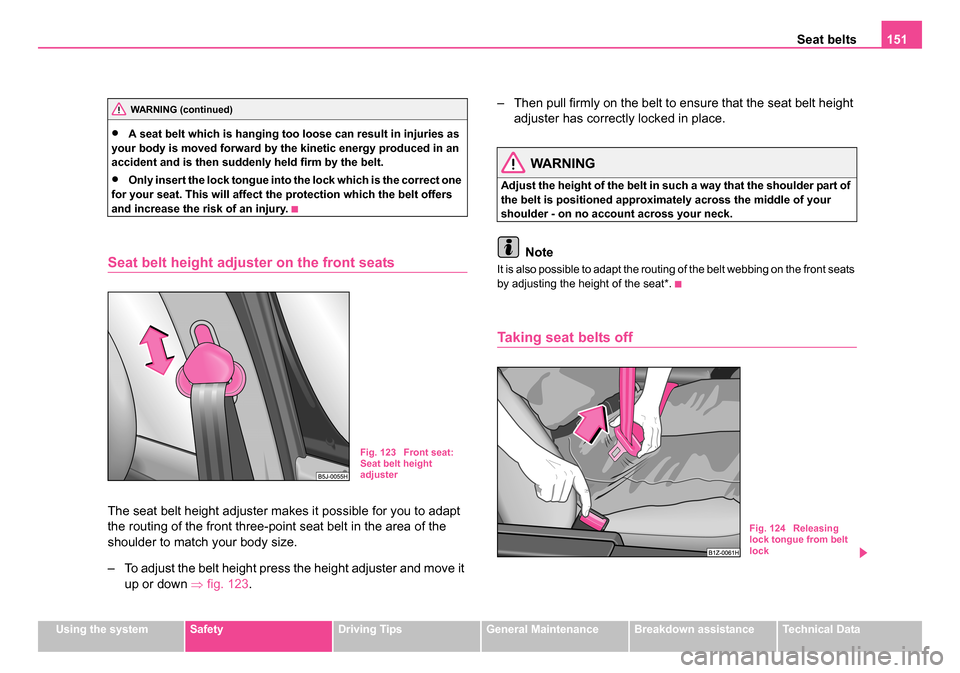
Seat belts151
Using the systemSafetyDriving TipsGeneral MaintenanceBreakdown assistanceTechnical Data
•A seat belt which is hanging too loose can result in injuries as
your body is moved forward by the kinetic energy produced in an
accident and is then suddenly held firm by the belt.
•Only insert the lock tongue into the lock which is the correct one
for your seat. This will affect the protection which the belt offers
and increase the risk of an injury.
Seat belt height adju ster on the front seats
The seat belt height adjuster makes it possible for you to adapt
the routing of the front three-point seat belt in the area of the
shoulder to match your body size.
– To adjust the belt height press the height adjuster and move it
up or down ⇒fig. 123 . – Then pull firmly on the belt to ensure that the seat belt height
adjuster has correctly locked in place.
WARNING
Adjust the height of the belt in such a way that the shoulder part of
the belt is positioned approximately across the middle of your
shoulder - on no account across your neck.
Note
It is also possible to adapt the routing of the belt webbing on the front seats
by adjusting the height of the seat*.
Taking seat belts off
WARNING (continued)
Fig. 123 Front seat:
Seat belt height
adjuster
Fig. 124 Releasing
lock tongue from belt
lock
NKO 20 A05.book Page 151 Wednesday, June 21, 2006 1:42 PM
Page 153 of 274
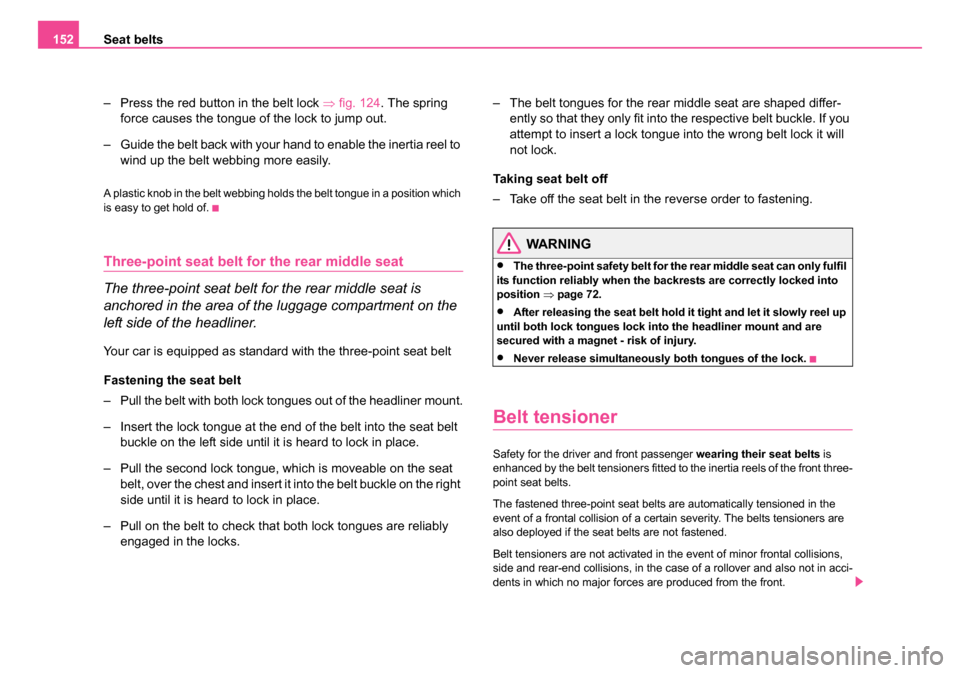
Seat belts
152
– Press the red button in the belt lock ⇒fig. 124 . The spring
force causes the tongue of the lock to jump out.
– Guide the belt back with your hand to enable the inertia reel to wind up the belt webbing more easily.
A plastic knob in the belt webbing holds the belt tongue in a position which
is easy to get hold of.
Three-point seat belt fo r the rear middle seat
The three-point seat belt for the rear middle seat is
anchored in the area of the luggage compartment on the
left side of the headliner.
Your car is equipped as standard with the three-point seat belt
Fastening the seat belt
– Pull the belt with both lock tongues out of the headliner mount.
– Insert the lock tongue at the end of the belt into the seat belt buckle on the left side until it is heard to lock in place.
– Pull the second lock tongue, which is moveable on the seat belt, over the chest and insert it into the belt buckle on the right
side until it is heard to lock in place.
– Pull on the belt to check that both lock tongues are reliably engaged in the locks. – The belt tongues for the rear middle seat are shaped differ-
ently so that they only fit into the respective belt buckle. If you
attempt to insert a lock tongue into the wrong belt lock it will
not lock.
Taking seat belt off
– Take off the seat belt in the reverse order to fastening.
WARNING
•The three-point safety belt for the rear middle seat can only fulfil
its function reliably when the backrests are correctly locked into
position ⇒page 72.
•After releasing the seat belt hold it tight and let it slowly reel up
until both lock tongues lock into the headliner mount and are
secured with a magnet - risk of injury.
•Never release simultaneously both tongues of the lock.
Belt tensioner
Safety for the driver and front passenger wearing their seat belts is
enhanced by the belt tensioners fitted to the inertia reels of the front three-
point seat belts.
The fastened three-point seat belts are automatically tensioned in the
event of a frontal collision of a certain severity. The belts tensioners are
also deployed if the seat belts are not fastened.
Belt tensioners are not activated in the event of minor frontal collisions,
side and rear-end collisions, in the case of a rollover and also not in acci-
dents in which no major forces are produced from the front.
NKO 20 A05.book Page 152 Wednesday, June 21, 2006 1:42 PM
Page 154 of 274

Seat belts153
Using the systemSafetyDriving TipsGeneral MaintenanceBreakdown assistanceTechnical Data
WARNING
•Any work on the belt tightener system, including removal and
installation of system components because of other repair work,
must only be carried out by a specialist garage.
•The protective function of the system is only adequate for a
single accident. If the belt tensioners have been deployed, it is then
necessary to replace the entire system.
•The Owner's Manual must also be handed over to the new
owner if the vehicle is sold.
Note
•Smoke is generated when the belt tensioners are deployed. This is not
an indication of a fire in the vehicle.
•It is essential to pay attention to relevant safety regulations if the
vehicle or individual parts of the system are scrapped. Škoda Service
Partners are familiar with these regulations and will be able to provide you
with detailed information in this respect.
•When disposing of vehicle or parts of the system, it is important to
comply with the national legal requirements.
NKO 20 A05.book Page 153 Wednesday, June 21, 2006 1:42 PM
Page 155 of 274
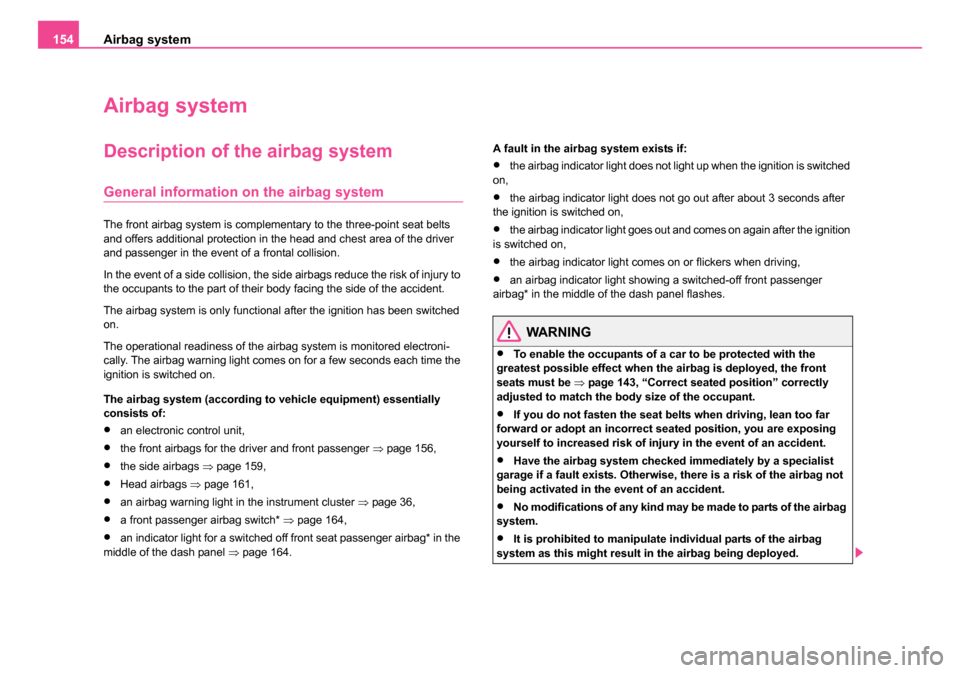
Airbag system
154
Airbag system
Description of the airbag system
General information on the airbag system
The front airbag system is complementary to the three-point seat belts
and offers additional protection in the head and chest area of the driver
and passenger in the event of a frontal collision.
In the event of a side collision, the side airbags reduce the risk of injury to
the occupants to the part of their body facing the side of the accident.
The airbag system is only functional after the ignition has been switched
on.
The operational readiness of the airbag system is monitored electroni-
cally. The airbag warning light comes on for a few seconds each time the
ignition is switched on.
The airbag system (according to vehicle equipment) essentially
consists of:
•an electronic control unit,
•the front airbags for the driver and front passenger ⇒page 156,
•the side airbags ⇒page 159,
•Head airbags ⇒page 161,
•an airbag warning light in the instrument cluster ⇒page 36,
•a front passenger airbag switch* ⇒page 164,
•an indicator light for a switched off front seat passenger airbag* in the
middle of the dash panel ⇒page 164. A fault in the airbag system exists if:
•the airbag indicator light does not light up when the ignition is switched
on,
•the airbag indicator light does not go out after about 3 seconds after
the ignition is switched on,
•the airbag indicator light goes out and comes on again after the ignition
is switched on,
•the airbag indicator light comes on or flickers when driving,
•an airbag indicator light showing a switched-off front passenger
airbag* in the middle of the dash panel flashes.
WARNING
•To enable the occupants of a car to be protected with the
greatest possible effect when the airbag is deployed, the front
seats must be ⇒page 143, “Correct seated position” correctly
adjusted to match the body size of the occupant.
•If you do not fasten the seat belts when driving, lean too far
forward or adopt an incorrect seated position, you are exposing
yourself to increased risk of injury in the event of an accident.
•Have the airbag system checked immediately by a specialist
garage if a fault exists. Otherwise, there is a risk of the airbag not
being activated in the event of an accident.
•No modifications of any kind may be made to parts of the airbag
system.
•It is prohibited to manipulate individual parts of the airbag
system as this might result in the airbag being deployed.
NKO 20 A05.book Page 154 Wednesday, June 21, 2006 1:42 PM
Page 156 of 274
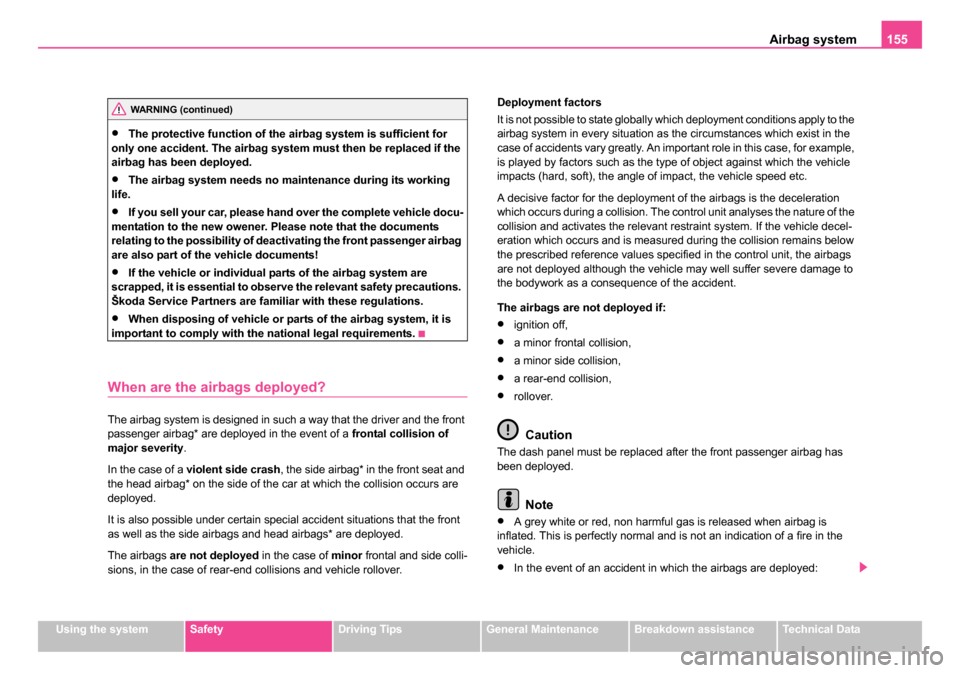
Airbag system155
Using the systemSafetyDriving TipsGeneral MaintenanceBreakdown assistanceTechnical Data
•The protective function of the airbag system is sufficient for
only one accident. The airbag system must then be replaced if the
airbag has been deployed.
•The airbag system needs no maintenance during its working
life.
•If you sell your car, please hand over the complete vehicle docu-
mentation to the new owener. Please note that the documents
relating to the possibility of deactivating the front passenger airbag
are also part of the vehicle documents!
•If the vehicle or individual parts of the airbag system are
scrapped, it is essential to observe the relevant safety precautions.
Škoda Service Partners are familiar with these regulations.
•When disposing of vehicle or parts of the airbag system, it is
important to comply with th e national legal requirements.
When are the airbags deployed?
The airbag system is designed in such a way that the driver and the front
passenger airbag* are deployed in the event of a frontal collision of
major severity .
In the case of a violent side crash , the side airbag* in the front seat and
the head airbag* on the side of the car at which the collision occurs are
deployed.
It is also possible under certain special accident situations that the front
as well as the side airbags and head airbags* are deployed.
The airbags are not deployed in the case of minor frontal and side colli-
sions, in the case of rear-end collisions and vehicle rollover. Deployment factors
It is not possible to state globally which deployment conditions apply to the
airbag system in every situation as the circumstances which exist in the
case of accidents vary greatly. An important role in this case, for example,
is played by factors such as the type of object against which the vehicle
impacts (hard, soft), the angle of impact, the vehicle speed etc.
A decisive factor for the deployment of the airbags is the deceleration
which occurs during a collision. The control unit analyses the nature of the
collision and activates the relevant restraint system. If the vehicle decel-
eration which occurs and is measured during the collision remains below
the prescribed reference values specified in the control unit, the airbags
are not deployed although the vehicle may well suffer severe damage to
the bodywork as a consequence of the accident.
The airbags are not deployed if:
•ignition off,
•a minor frontal collision,
•a minor side collision,
•a rear-end collision,
•rollover.
Caution
The dash panel must be replaced after the front passenger airbag has
been deployed.
Note
•A grey white or red, non harmful gas is released when airbag is
inflated. This is perfectly normal and is not an indication of a fire in the
vehicle.
•In the event of an accident in which the airbags are deployed:
WARNING (continued)
NKO 20 A05.book Page 155 Wednesday, June 21, 2006 1:42 PM
Page 157 of 274
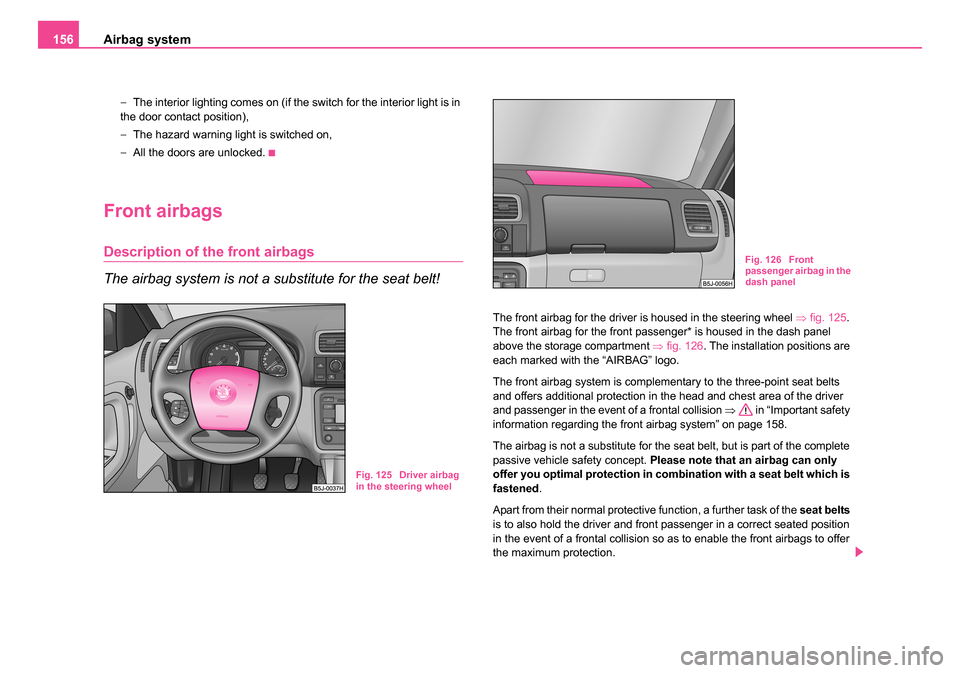
Airbag system
156
− The interior lighting comes on (if the switch for the interior light is in
the door contact position),
− The hazard warning light is switched on,
− All the doors are unlocked.
Front airbags
Description of the front airbags
The airbag system is not a substitute for the seat belt!
The front airbag for the driver is housed in the steering wheel ⇒fig. 125 .
The front airbag for the front passenger* is housed in the dash panel
above the storage compartment ⇒fig. 126 . The installation positions are
each marked with the “AIRBAG” logo.
The front airbag system is complementary to the three-point seat belts
and offers additional protection in the head and chest area of the driver
and passenger in the event of a frontal collision ⇒ in “Important safety
information regarding the front airbag system” on page 158.
The airbag is not a substitute for the seat belt, but is part of the complete
passive vehicle safety concept. Please note that an airbag can only
offer you optimal protection in combination with a seat belt which is
fastened .
Apart from their normal protective function, a further task of the seat belts
is to also hold the driver and front passenger in a correct seated position
in the event of a frontal collision so as to enable the front airbags to offer
the maximum protection.
Fig. 125 Driver airbag
in the steering wheel
Fig. 126 Front
passenger airbag in the
dash panel
NKO 20 A05.book Page 156 Wednesday, June 21, 2006 1:42 PM
Page 158 of 274
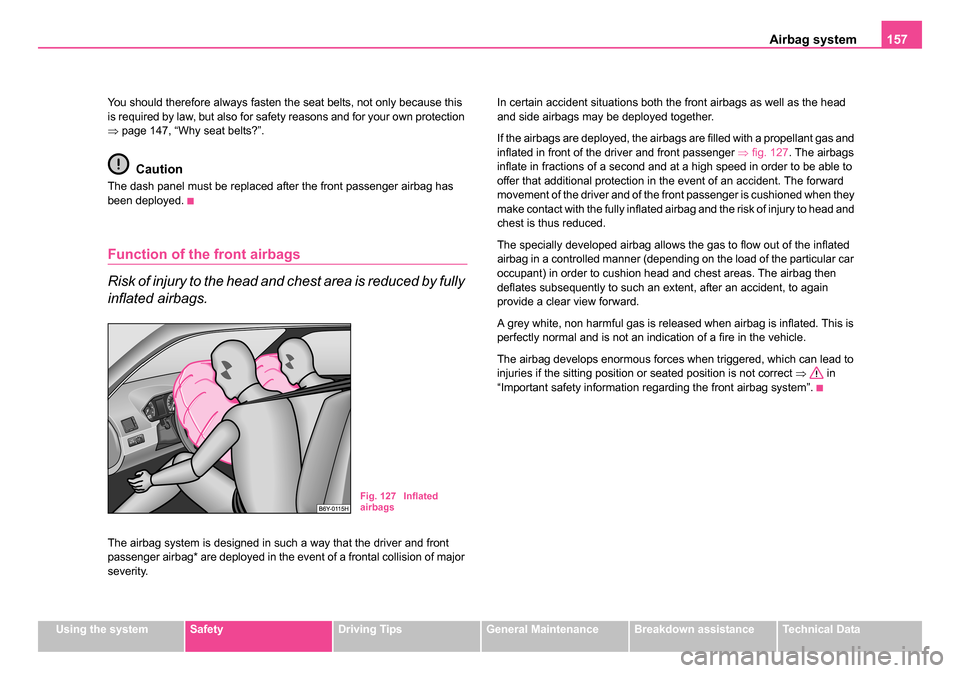
Airbag system157
Using the systemSafetyDriving TipsGeneral MaintenanceBreakdown assistanceTechnical Data
You should therefore always fasten the seat belts, not only because this
is required by law, but also for safety reasons and for your own protection
⇒
page 147, “Why seat belts?”.
Caution
The dash panel must be replaced after the front passenger airbag has
been deployed.
Function of the front airbags
Risk of injury to the head and chest area is reduced by fully
inflated airbags.
The airbag system is designed in such a way that the driver and front
passenger airbag* are deployed in the event of a frontal collision of major
severity. In certain accident situations both the front airbags as well as the head
and side airbags may be deployed together.
If the airbags are deployed, the airbags are filled with a propellant gas and
inflated in front of the driver and front passenger
⇒fig. 127 . The airbags
inflate in fractions of a second and at a high speed in order to be able to
offer that additional protection in the event of an accident. The forward
movement of the driver and of the front passenger is cushioned when they
make contact with the fully inflated airbag and the risk of injury to head and
chest is thus reduced.
The specially developed airbag allows the gas to flow out of the inflated
airbag in a controlled manner (depending on the load of the particular car
occupant) in order to cushion head and chest areas. The airbag then
deflates subsequently to such an extent, after an accident, to again
provide a clear view forward.
A grey white, non harmful gas is released when airbag is inflated. This is
perfectly normal and is not an indication of a fire in the vehicle.
The airbag develops enormous forces when triggered, which can lead to
injuries if the sitting position or seated position is not correct ⇒ in
“Important safety information regarding the front airbag system”.
Fig. 127 Inflated
airbags
NKO 20 A05.book Page 157 Wednesday, June 21, 2006 1:42 PM
Page 159 of 274
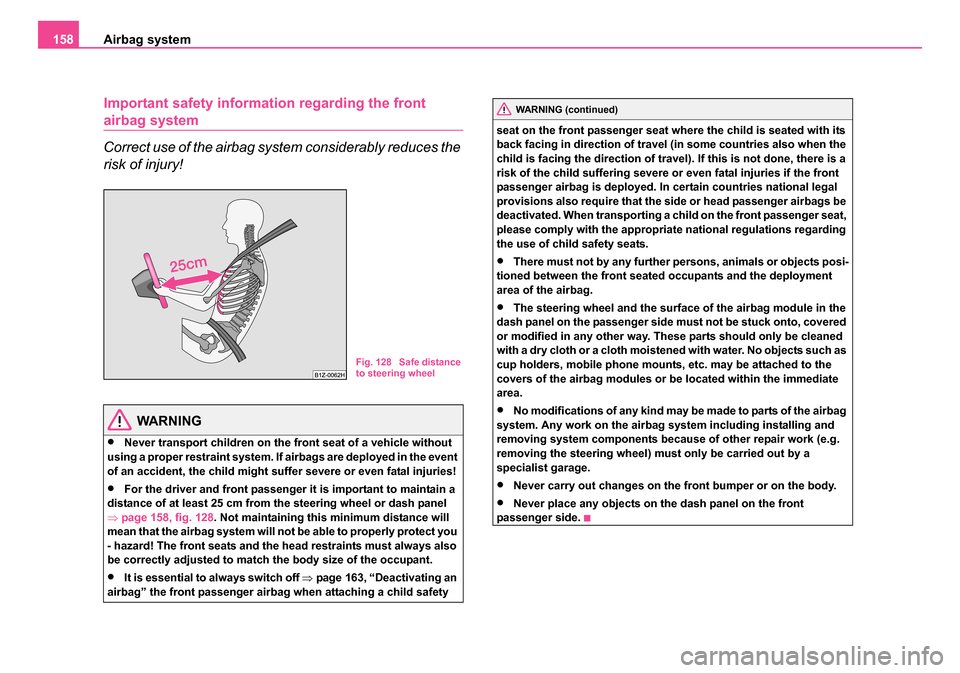
Airbag system
158
Important safety informat ion regarding the front
airbag system
Correct use of the airbag system considerably reduces the
risk of injury!
WARNING
•Never transport children on the front seat of a vehicle without
using a proper restraint system. If airbags are deployed in the event
of an accident, the child might suff er severe or even fatal injuries!
•For the driver and front passenger it is important to maintain a
distance of at least 25 cm from the steering wheel or dash panel
⇒ page 158, fig. 128 . Not maintaining this minimum distance will
mean that the airbag sy stem will not be able to properly protect you
- hazard! The front seats and the head restraints must always also
be correctly adjusted to match the body size of the occupant.
•It is essential to always switch off ⇒page 163, “Deactivating an
airbag” the front passenger airbag when attaching a child safety seat on the front passenger seat where the child is seated with its
back facing in direction of travel (in some countries also when the
child is facing the direction of travel). If this is not done, there is a
risk of the child suffering severe or
even fatal injuries if the front
passenger airbag is deployed. In certain countries national legal
provisions also require that the side or head passenger airbags be
deactivated. When transporting a child on the front passenger seat,
please comply with the appropriat e national regulations regarding
the use of child safety seats.
•There must not by any further persons, animals or objects posi-
tioned between the front seated occupants and the deployment
area of the airbag.
•The steering wheel and the surface of the airbag module in the
dash panel on the passenger side must not be stuck onto, covered
or modified in any other way. Th ese parts should only be cleaned
with a dry cloth or a cloth moistened with water. No objects such as
cup holders, mobile phone mounts, etc. may be attached to the
covers of the airbag modules or be located within the immediate
area.
•No modifications of any kind may be made to parts of the airbag
system. Any work on the airbag system including installing and
removing system components because of other repair work (e.g.
removing the steering wheel) must only be carried out by a
specialist garage.
•Never carry out changes on the front bumper or on the body.
•Never place any objects on the dash panel on the front
passenger side.
Fig. 128 Safe distance
to steering wheel
WARNING (continued)
NKO 20 A05.book Page 158 Wednesday, June 21, 2006 1:42 PM
Page 160 of 274
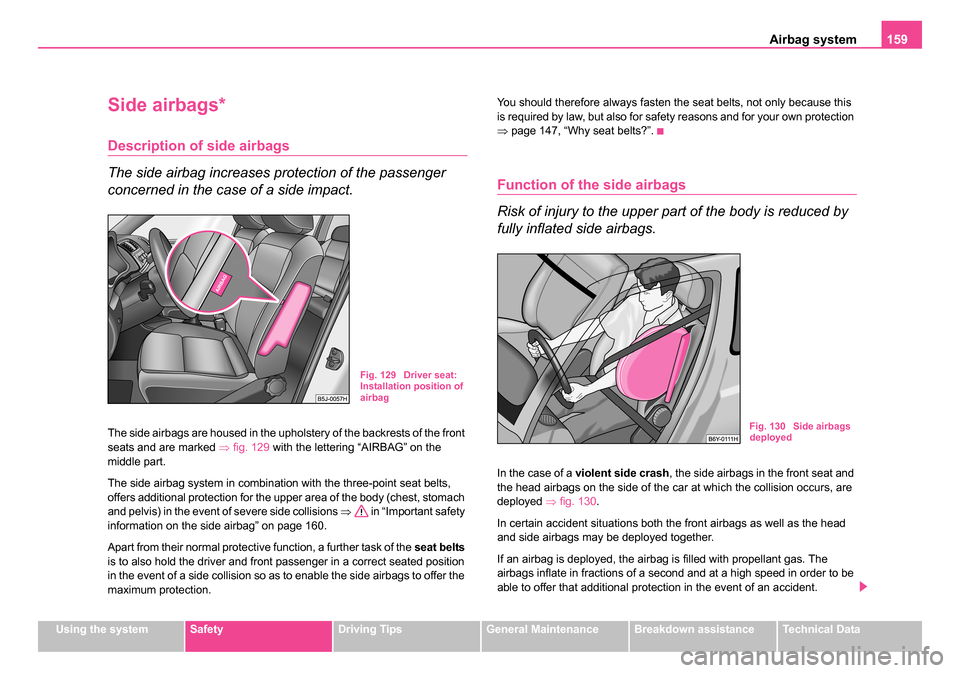
Airbag system159
Using the systemSafetyDriving TipsGeneral MaintenanceBreakdown assistanceTechnical Data
Side airbags*
Description of side airbags
The side airbag increases protection of the passenger
concerned in the case of a side impact.
The side airbags are housed in the upholstery of the backrests of the front
seats and are marked ⇒fig. 129 with the lettering “AIRBAG” on the
middle part.
The side airbag system in combination with the three-point seat belts,
offers additional protection for the upper area of the body (chest, stomach
and pelvis) in the event of severe side collisions ⇒ in “Important safety
information on the side airbag” on page 160.
Apart from their normal protective function, a further task of the seat belts
is to also hold the driver and front passenger in a correct seated position
in the event of a side collision so as to enable the side airbags to offer the
maximum protection. You should therefore always fasten the seat belts, not only because this
is required by law, but also for safety reasons and for your own protection
⇒
page 147, “Why seat belts?”.
Function of the side airbags
Risk of injury to the upper part of the body is reduced by
fully inflated side airbags.
In the case of a violent side crash , the side airbags in the front seat and
the head airbags on the side of the car at which the collision occurs, are
deployed ⇒fig. 130 .
In certain accident situations both the front airbags as well as the head
and side airbags may be deployed together.
If an airbag is deployed, the airbag is filled with propellant gas. The
airbags inflate in fractions of a second and at a high speed in order to be
able to offer that additional protection in the event of an accident.
Fig. 129 Driver seat:
Installation position of
airbag
Fig. 130 Side airbags
deployed
NKO 20 A05.book Page 159 Wednesday, June 21, 2006 1:42 PM